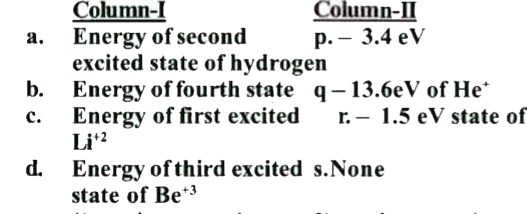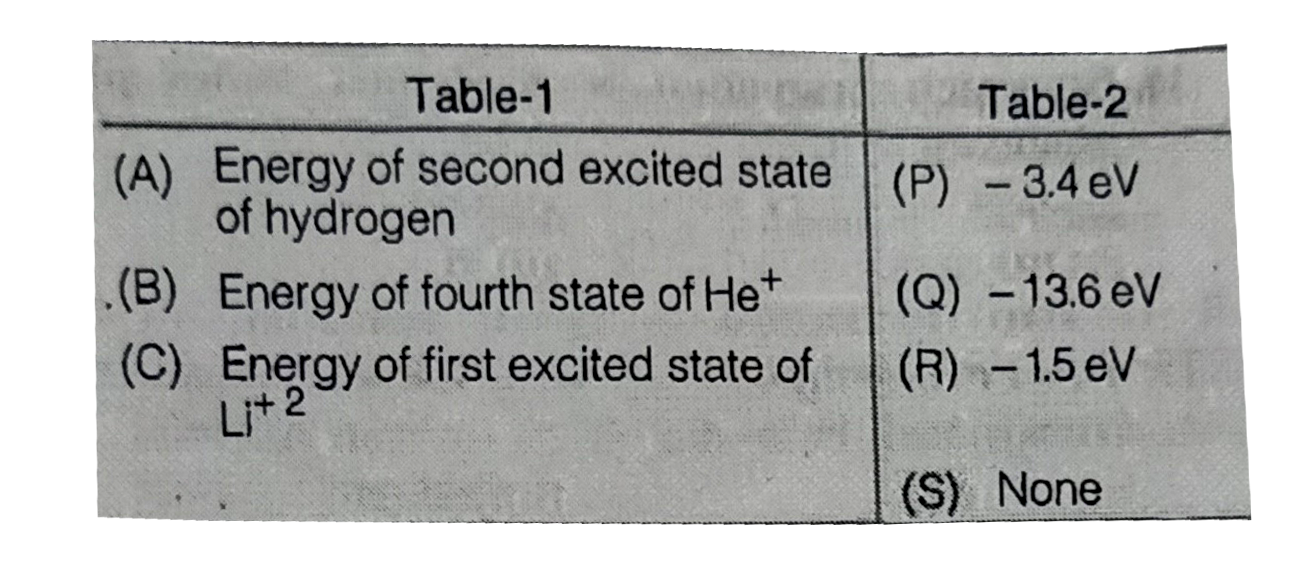The ionisation energy of hydrogen atom is 13.6 eV. Calculate Rydberg's constant for hydrogen.
The correct Answer is:1.0956×107m−1
To calculate Rydberg's constant for hydrogen using the given ionization energy, we will follow these steps:
1. Understand the Ionization Energy: The ionization energy of the hydrogen atom is given as 13.6 eV. This is the energy required to remove the electron from the ground state (n=1) to infinity (n=∞).
2. Convert Ionization Energy to Joules:
E=13.6 eV×1.6×10−19 J/eV=2.176×10−18 J
3. Use the Energy-Wavelength Relationship: The energy of a photon can be expressed in terms of its frequency (ν) or wavelength (λ):
E=hν=hcλ
where h is Planck's constant and c is the speed of light.
4. Apply the Rydberg Formula: The Rydberg formula for the wavelength of emitted or absorbed light during transitions in hydrogen is:
1λ=R(1n21−1n22)
For ionization from the ground state (n=1) to infinity (n=∞):
1λ=R(112−1∞2)=R(1−0)=R
5. Relate Energy to Rydberg's Constant: From the energy equation, we can write:
E=hcλ
Substituting λ from the Rydberg formula:
E=hc⋅1R
Rearranging gives:
R=hcE
6. Substitute Known Values:
- Planck's constant h=6.626×10−34 J s
- Speed of light c=3×108 m/s
- Energy E=2.176×10−18 J
Now substituting these values into the equation for R:
R=(6.626×10−34 J s)×(3×108 m/s)2.176×10−18 J
7. Calculate Rydberg's Constant:
R=1.9878×10−252.176×10−18≈9.13×106 m−1
8. Final Result: The Rydberg constant for hydrogen is approximately:
R≈1.097×107 m−1
E=13.6 eV×1.6×10−19 J/eV=2.176×10−18 J
E=hν=hcλ
where h is Planck's constant and c is the speed of light.
1λ=R(1n21−1n22)
For ionization from the ground state (n=1) to infinity (n=∞):
1λ=R(112−1∞2)=R(1−0)=R
E=hcλ
Substituting λ from the Rydberg formula:
E=hc⋅1R
Rearranging gives:
R=hcE
- Planck's constant h=6.626×10−34 J s
- Speed of light c=3×108 m/s
- Energy E=2.176×10−18 J
R=(6.626×10−34 J s)×(3×108 m/s)2.176×10−18 J
R=1.9878×10−252.176×10−18≈9.13×106 m−1
R≈1.097×107 m−1
Topper's Solved these Questions
- BOOK - PRADEEPCHAPTER - ATOMS AND NUCLEIEXERCISE - Fill in the blank 21videos
ATOMS AND NUCLEI
- BOOK - PRADEEPCHAPTER - ATOMS AND NUCLEIEXERCISE - Multiple choice questions 11videos
ATOMS AND NUCLEI
- BOOK - PRADEEPCHAPTER - ATOMS AND NUCLEIEXERCISE - curiocity quetions 31videos
ATOMS AND NUCLEI
- BOOK - PRADEEPCHAPTER - COMMUNICATION SYSTEMSEXERCISE - MODEL TEST PAPER-29videos
COMMUNICATION SYSTEMS
Similar Questions
Knowledge Check
- Question 1 - Select One
Rydberg's constant for hydrogen line is-
A109678cm−1B109.678cm−1C1096.78cm−1D10.9678cm−1 - Question 2 - Select One
Excitation energy of hydrogen atom is 13.6eV. Match the following .
 Aa-r b-p c-s d-qBa-r b-s c-p d-qCa-s b-p c-q d-rDa-q b-p c-s d-r
Aa-r b-p c-s d-qBa-r b-s c-p d-qCa-s b-p c-q d-rDa-q b-p c-s d-r - Question 3 - Select One
The ionisation energy of hydrogen atom is 13.6eV. What is the ionisation energy of He ?
A−27.2eVB+27.2eVC+54.4eVD−54.4eV
(a) The electronic in Bohr's orbit is negative. How will you account for it ?
(b) The ionisation energy of hydrogen atom is 13.6 eV. What will be the energy of the first orbit of He+andLi2+ ions are ?View SolutionThe ionisation energy of H atom is 13.6 eV. What will be the ionisation energy of He⊕ and Li2+ ions ?
View SolutionThe ionization energy of hydrogen atom is 13.6 eV. Hydrogen atoms in the ground state are excited by electromagnetic radiation of energy 12.1 eV. How many spectral lines will be emitted by the hydrogen atoms
View SolutionThe ionisation energy of hydrogen atom is 13.6eV. Following Bohr's theory, the energy corresponding to a transition between the 3rd and the 4th orbit is
View SolutionIf the ionisation energy of hydrogen atom is 13.6 eV, the energy required to excite it from ground state to the next higher state is nearly
View Solution


